
 Skip to content
Skip to content
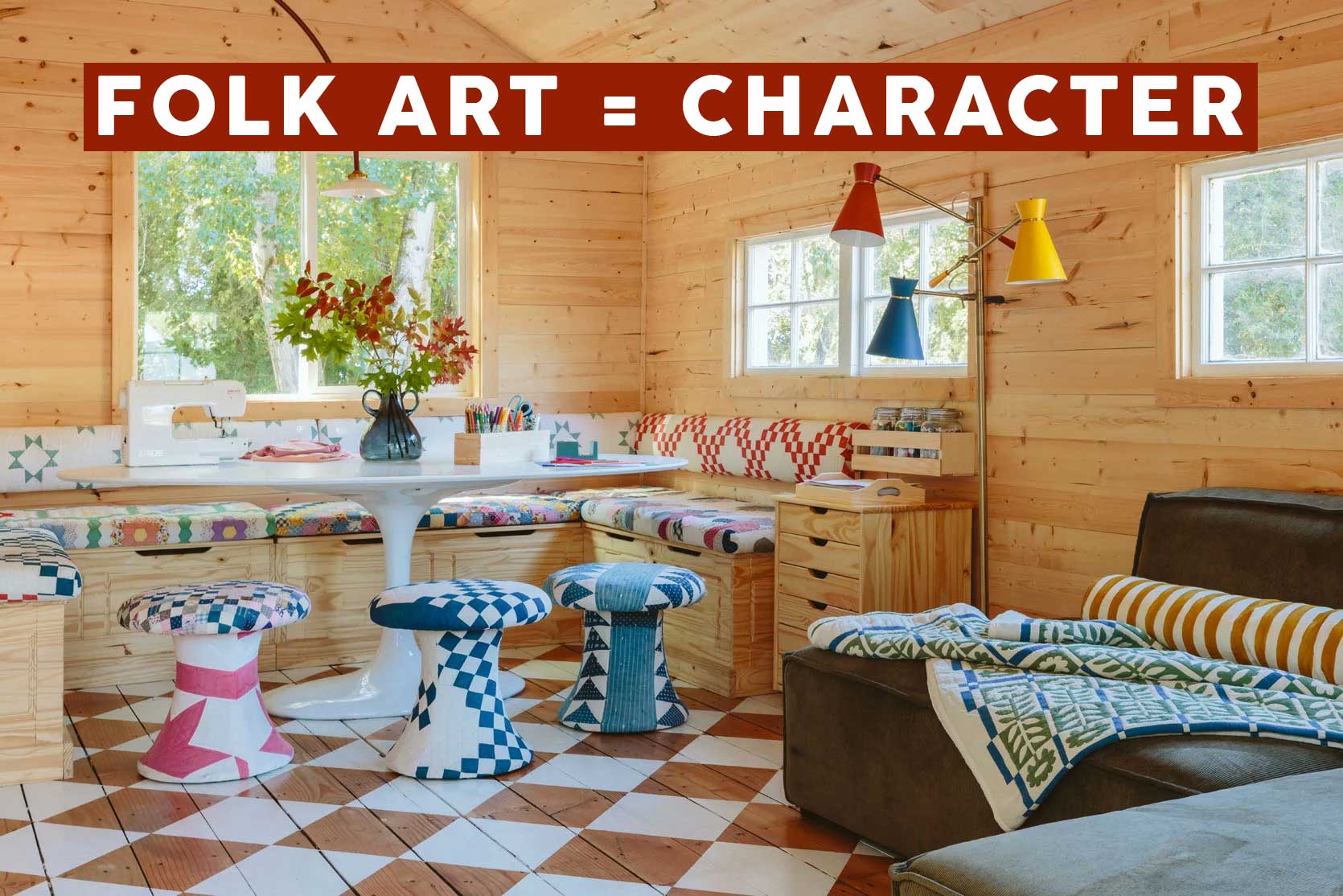
What Really IS Folk Art?? And How Do They Look Based On Where They’re From?
Welcome to another installment in my unofficial guide to non-cookie-cutter design. My first take explored the beauty of ethnic textiles, global and ethnic design; my second, a plea for designing for whimsy rather than chicness. Today, we’re diving into a topic that I lightly touched on earlier this year, in a team shopping post about what we were on the hunt for in our homes in 2025: folk art. In it, I explained that I would love to stumble upon a Scandinavian hand-painted folk art dresser or chest for my daughter’s bedroom, as she absolutely adores the “Frozen” movies. When I was first introduced to Anna and Elsa a decade ago, I didn’t even notice all the gorgeous painted scrollwork and florals adorning millwork, doors, walls, and textiles. But after seeing the films enough to have them imprinted in my veins, it’s what I enjoy most about the visuals.
Then, as if tapped into my soul, Caitlin wrote a piece on a Scandinavian folk art furniture trend she was noticing. That article has been tucked away in my mind since she published it, and I had the itch to expand on the topic. But I’m not just stopping at Swedish or Norwegian folk art; there is a wide world of it to know more about and admire. Let’s go.
What Exactly Is Folk Art?
To establish what we’re talking about here, folk art and folk craft are amateur art made by the people, for the people. It’s how most cultures over time have kept their traditions, lore, and people alive. It’s a visual art that was predominantly utilitarian or affixed to functional items, most often done by hand or with limited means. Folk art tells the stories of people and their beliefs across time, and honestly, that alone is so beautiful to me. It’s often colorful, geometric, or full of interesting figures and animals.
While folk art can touch all areas of life, like with music and practical art, we’re here to talk about the home, after all. Quilts, tapestries, ceramics, wall hangings, embroidery, sculptures, framed art, and furniture made or crafted by common folk (i.e., not trained artists for the means of selling for profit) are all examples of folk art—hence the name.
In my mind, it’s kind of like the original DIY of the decorative arts. And appropriately, there’s been a boom of folk-art style hand-painted creations at the hands of design DIYers and artists. While I do love the look of it, it’s important to note that a lot of the modern-day folk art we’re seeing lacks the cultural significance at the heart of it. It’s more aesthetic-forward than anything else. That’s not to say I would feel a way about implementing some Nordic folk art motifs in the room of my Afro-Caribbean daughter, but it does make me want to do some research on the traditional art styles of both my and my husband’s heritage.
I could wax poetic about this until everyone is bored, so let’s keep it moving, as there is a lot to talk through (plus some shopping!). First, beautiful inspirations and aspirations…
Let’s Look At Some Folk Art Beauties
Swedish and other Scandinavian folk art is often seen around “box beds” that were common in the region (the inset nooks often provided more warmth and privacy). As ornate millwork in our homes has made a huge comeback in the recent decade, I’ve seen more alcoves like this popping up in designer projects. Hand-painted florals and scrollwork really make these come to life and are just so special.
I’ve always had a soft spot in my heart for ornately painted furniture. It has a distinctly cottage-y feel, which I love in small doses in a charming or even stripped-back room design. This type of folk art is the easiest to DIY if you like the look but can’t afford a thousand-plus-dollar antique, and was actually my current reentry into the folk painting world, as I mentioned.
Natasha Mann is a modern-day artist I love to follow for her folk sensibilities. She specializes in decorative painting with natural pigments and egg tempera on wood, which is how it was done originally. Her work, which you can see above and below, is intricate and just so beautiful, no matter its application.
How sweet are those sparse florals above the tub in the bathroom shot below? It’s such a sweet detail that doesn’t overwhelm. Similar to the daisy-like floral arrangements on this fridge in the kitchen of Brittany Jepsen from The House That Lars Built. Caitlin shared it in her original Swedish folk painting post, and I’ve loved it ever since.
Explore Some Popular Folk Art Provenance
Like I mentioned earlier, a lot of what we’re seeing in our feeds and saved folders is DIY, modern-day versions of folk art, and highly inspired by original pieces without cultural significance specific to the creator. As a reminder, folk art is highly specific to the people and places from which it originated. It’s my duty as a design writer to pay tribute to those and further explore their DNA. Of course, there are many, many types of folk art, from Guatemalan to Ecuadorian to Native and indigenous peoples and tribes, but here is a sampling of some beloved and often talked about folk art.
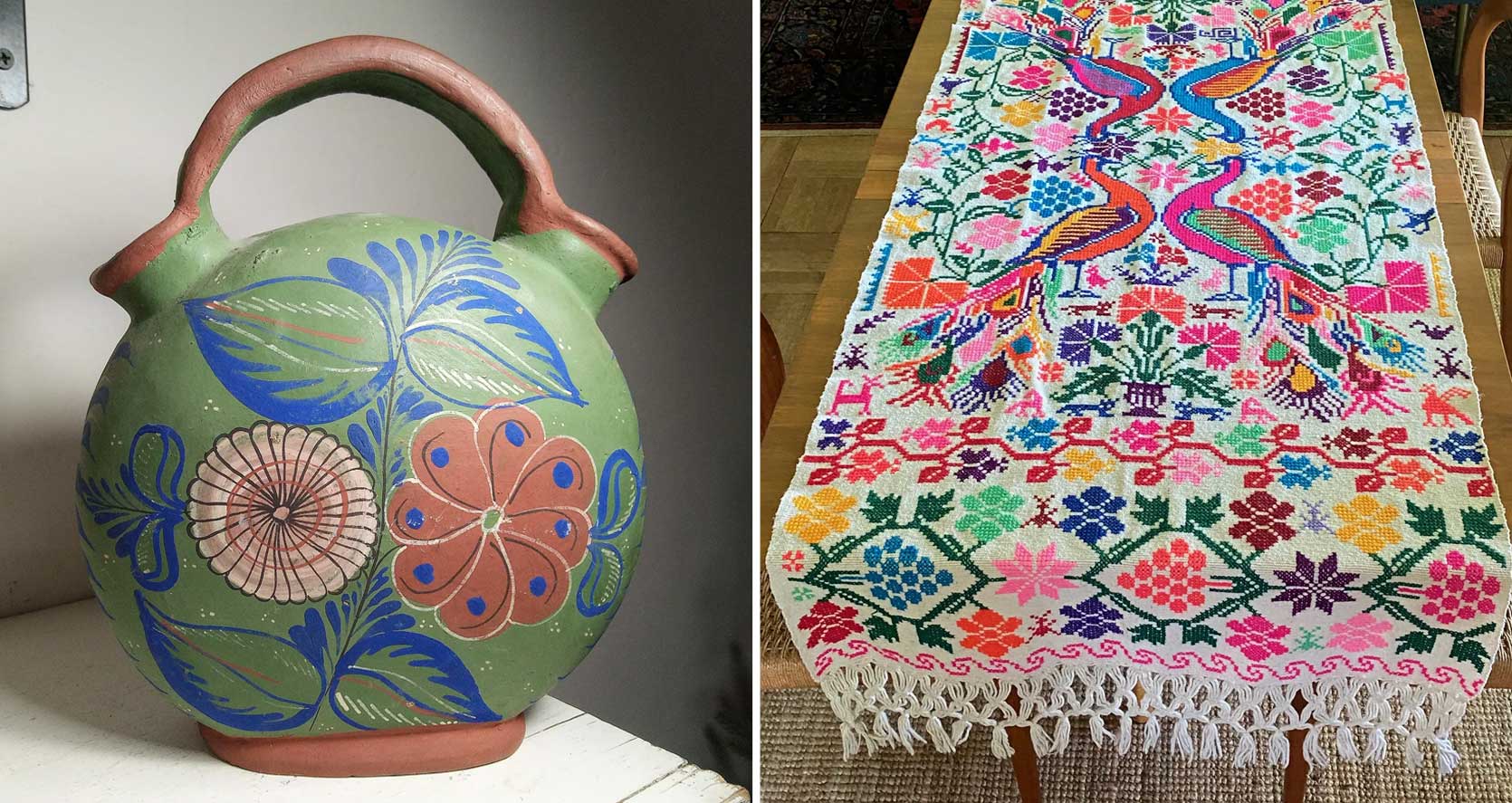
Mexican Folk Art: You’ll recognize Mexican folk art by its bright colors and narrative symbolism. Folk art from this area can be found on wood carvings, weavings, papel-mâché, tinwork, and glazing on terra-cotta ceramics. They have a strong link to festivals and rituals such as Dia de los Muertos. Common colors include turquoise, fuchsia, magenta, bright orange, sunflower yellow, cobalt blue, deep red, and vibrant green.
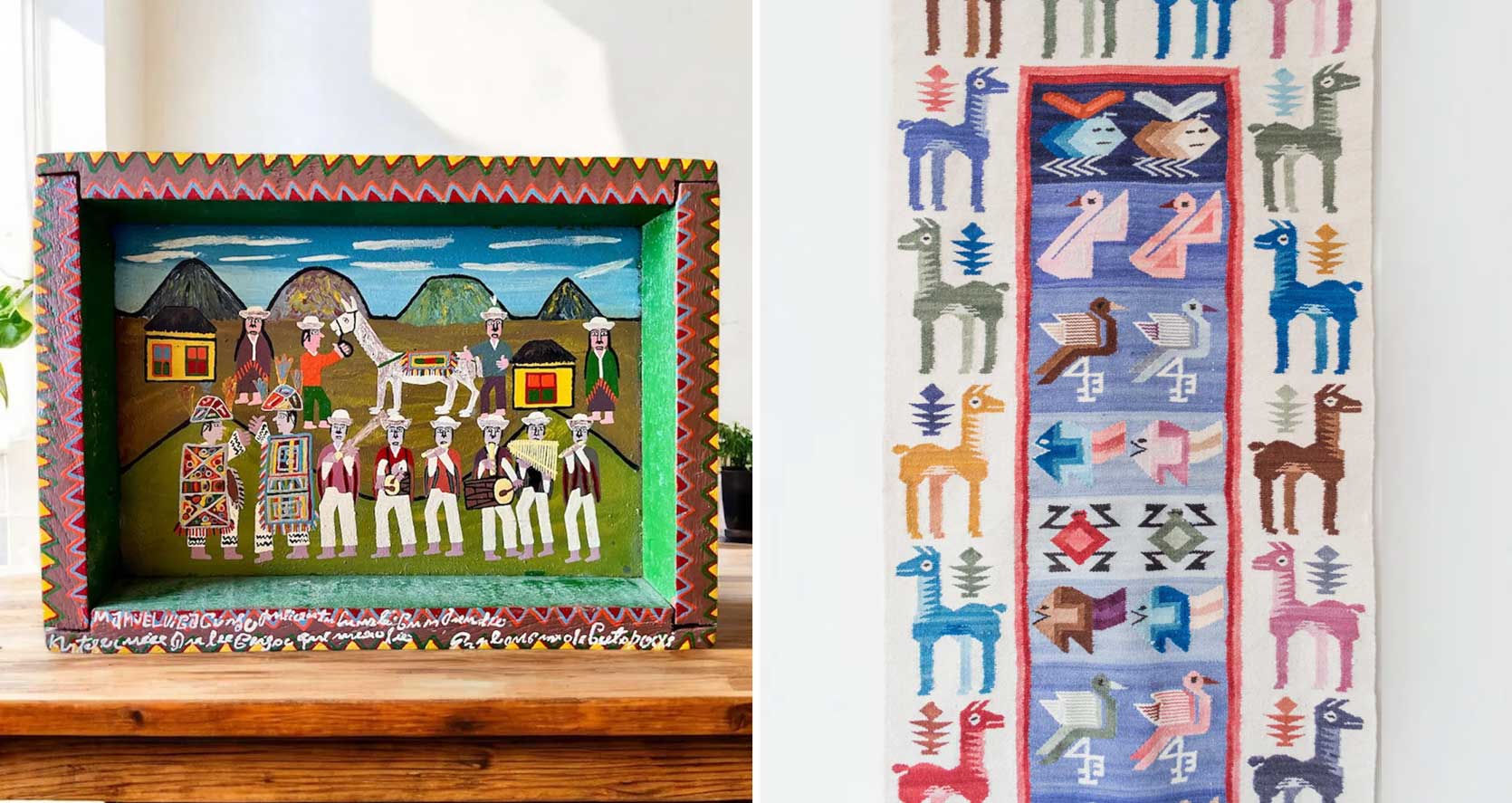
Peruvian Folk Art: Much of Peruvian folk art comes in the form of textiles such as Andean blankets that depict traditions and religious/devotional life, often with Catholic iconography (and llamas…lots of llamas). You’ll also find painted ceramics and carved wood with intricate patterns and narratives of festivals, saints, markets, and mythical stories. Common colors include deep reds, purples, browns, indigo, turquoise, bright pink, orange, and golden yellow.
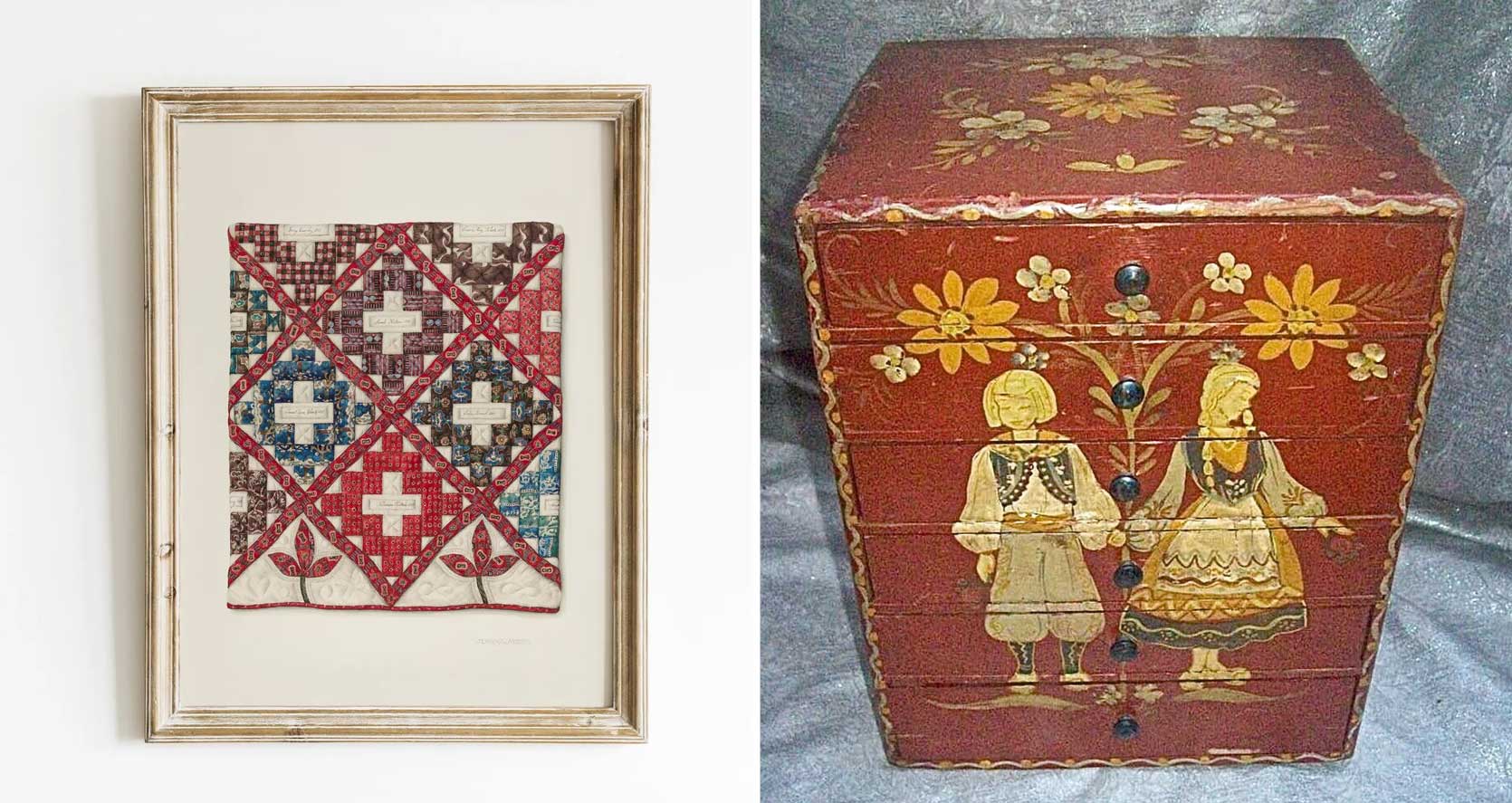
American Folk Art: Different from Central and South American folk art, North American folk art spans household crafts via quilting, patchwork, hooked rugs, and painted furniture and boxes. It shows some religious depictions, but most often, you’ll find more “personal” storytelling and practical scenes of everyday life. A lot of American folk art we still have today came from the Amish, Shakers, and Pennsylvania Dutch. The furniture is simple with functional wood joinery, and colors used throughout all forms of this folk art are often seen in muted earth tones, soft blues, barn red, darker yellow, and greens.
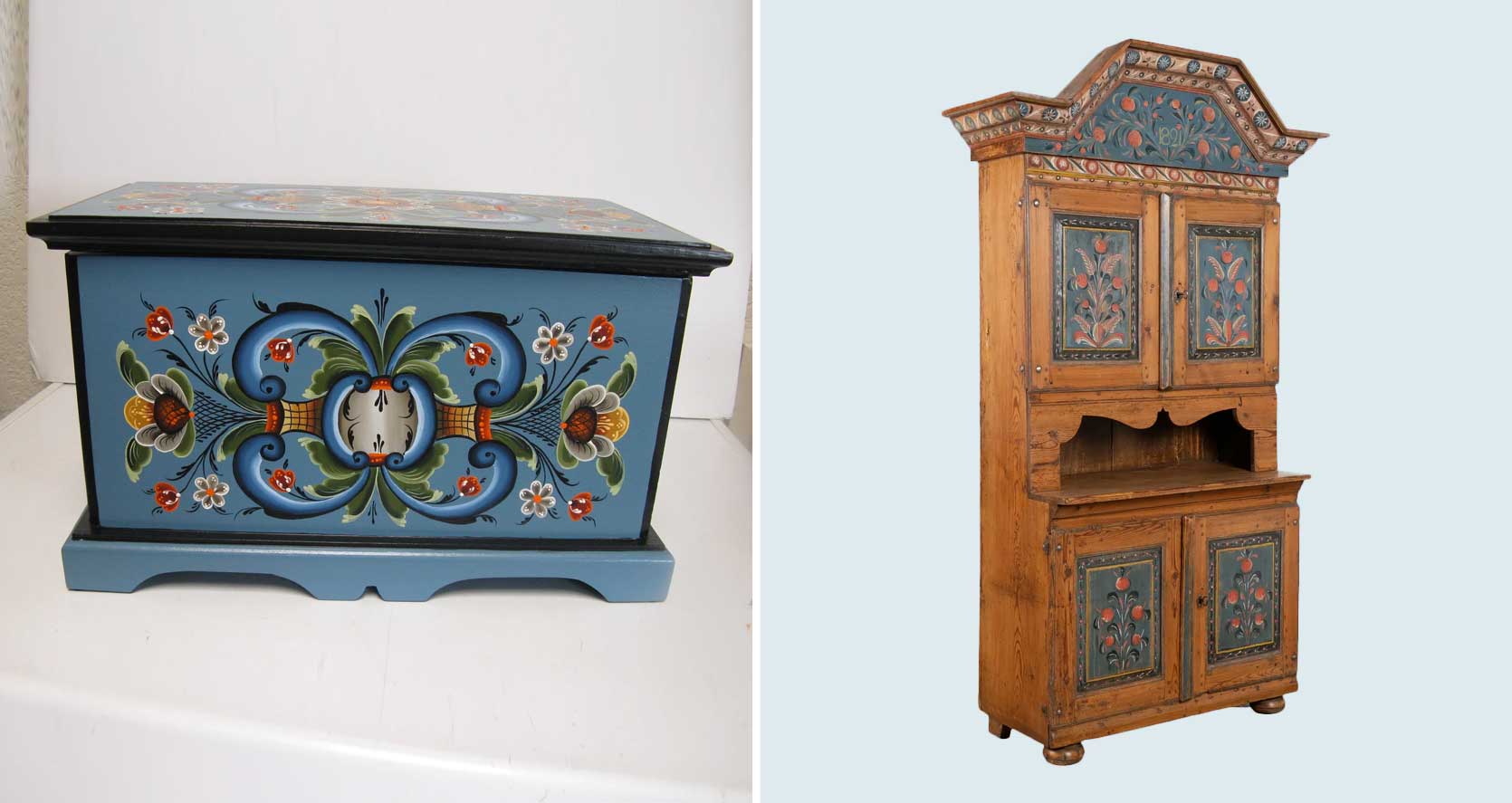
Scandinavian Folk Art: Folk art from Norway, Sweden, Denmark, and Finland falls under the label of Scandinavian folk art. This is quite popular right now thanks in great part to its softer, milkier blue and green colors. Scandinavian folk art can be found in hand-painted furniture and blanket boxes, textiles, carved wood household items, and embroidery. Most of the designs under this umbrella feature scrolling floral motifs called rosemalig. Colors are restrained and muted, typically in ochre, dusty blue and green, red, white, and gold.
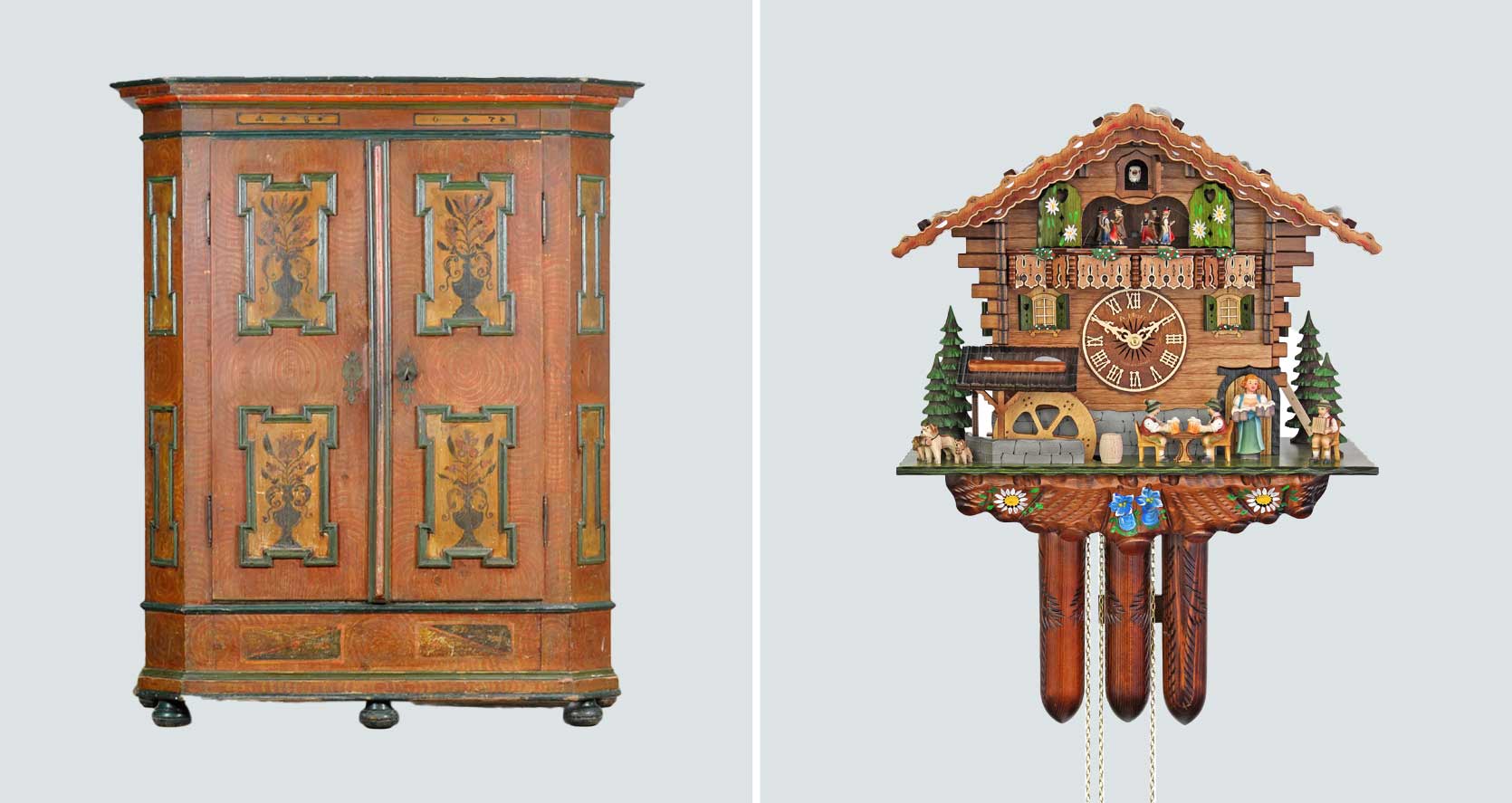
German Folk Art: German folk art is rooted in centuries-old woodcarving (think nutcrackers and cuckoo clocks), painted furniture, and symbolic pattern work tied to regional traditions (like Bavarian, Black Forest, and Alpine styles). American folk art was heavily influenced by German folk art through immigrants. They used a lot of milk paint, natural dyes and oils; in textiles, you’ll find meticulous tulips, hearts, birds and precise starburst motifs. Colors are varied depending on the region it came from, but you’ll find reds, deep greens, mustard, cobalt blue, black and ivory, sometimes with gilded accents.
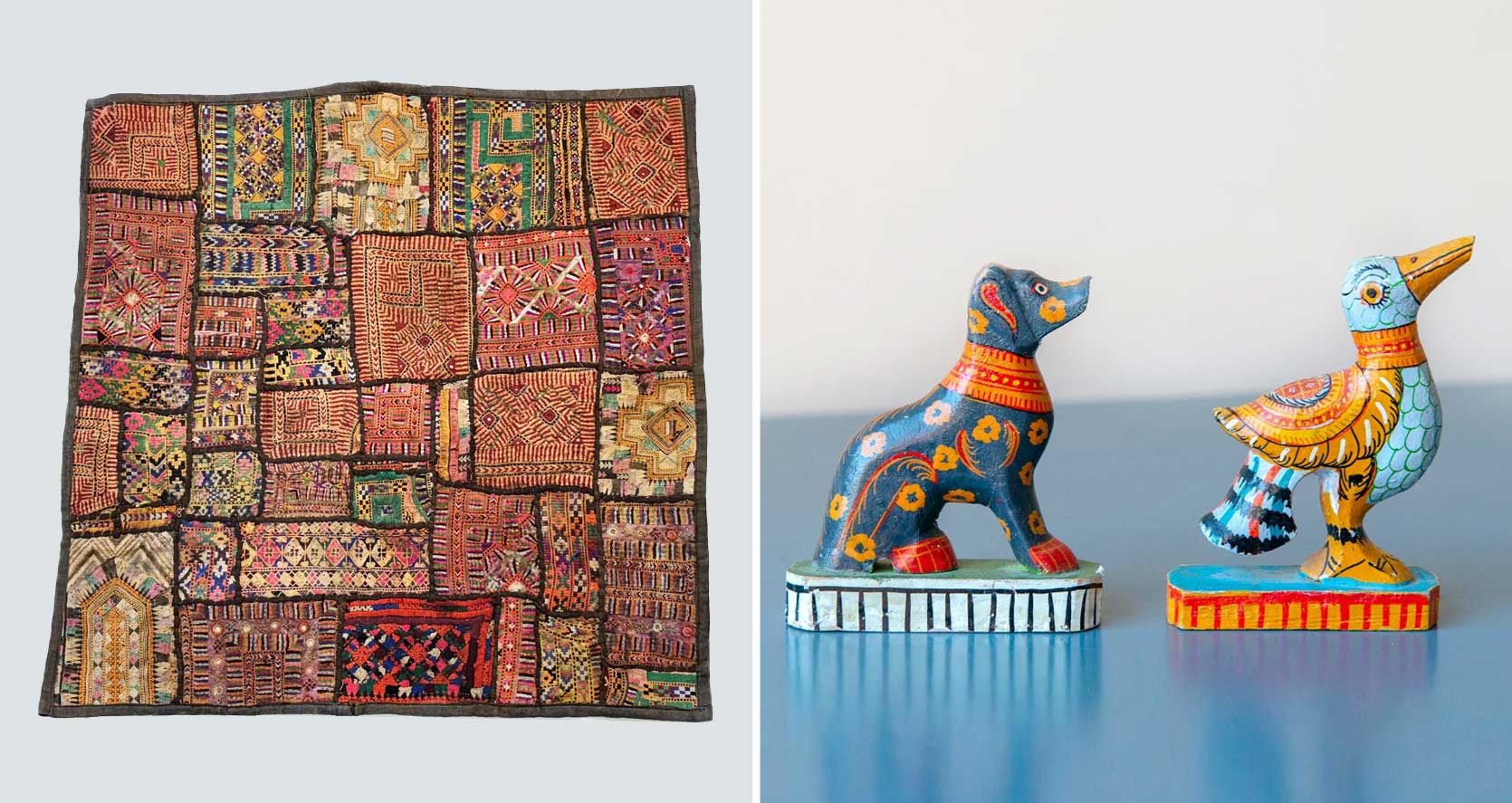
Indian Folk Art: One of the most diverse folk art stems from India, which has highly regionally specific creations. Scroll paintings, block-printed fabrics, and many other painted and woven art show ritual occasions, storytelling, and everyday objects. They used pigments made from minerals and plants in earthy reds, indigo, ochre, black and white. Madhubani and Pattachitra folk art features pops of emerald green, magenta, and orange, symbolizing fertility and celebration.
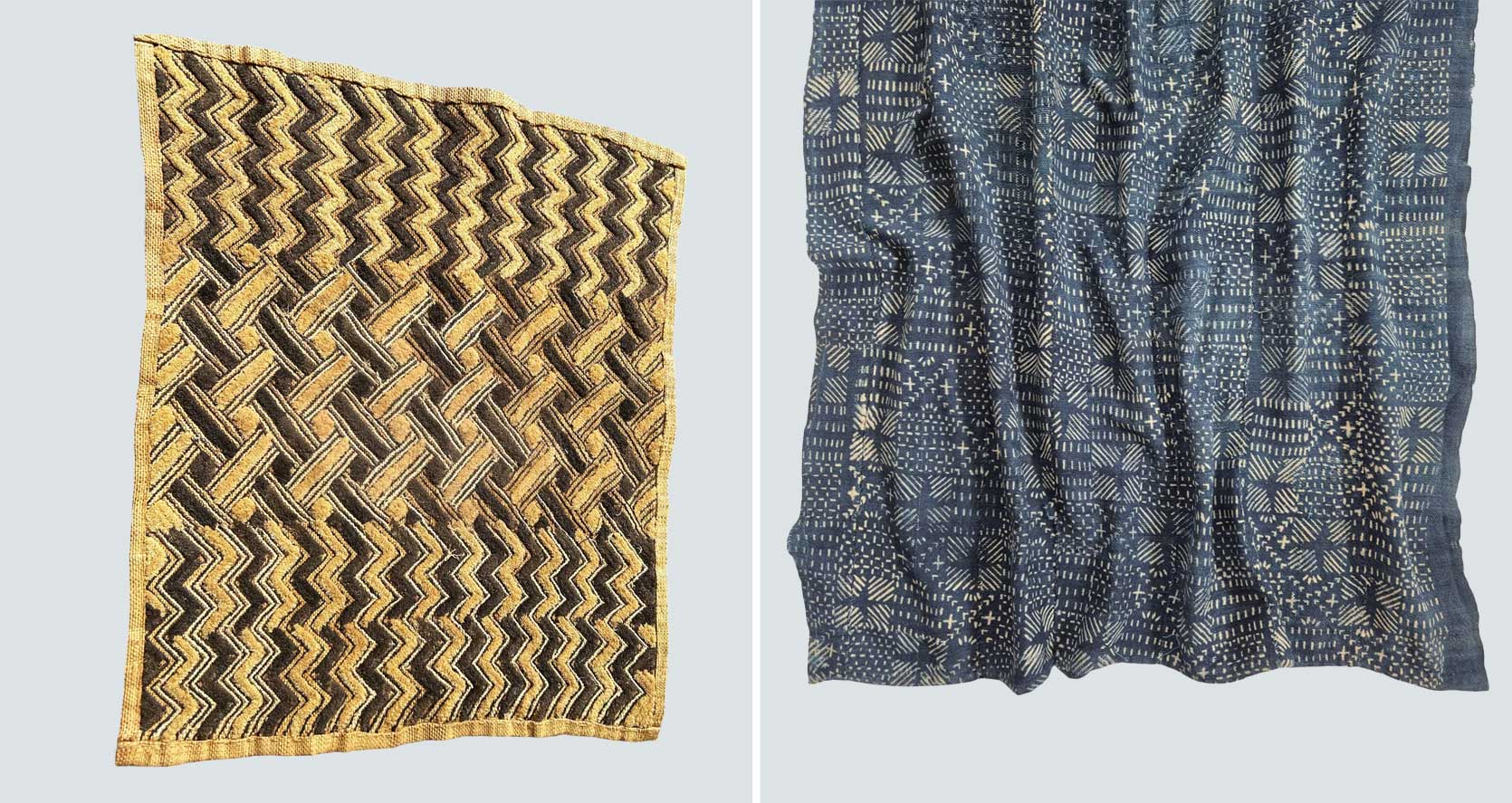
African Folk Art: You can find out more about some African folk art, like mudcloth and Kuba cloth in this article I recently wrote about global textiles, but as a refresher, folk art from the continent tends to use a lot of resist-dye processes, embroidery, and complex weaving techniques in bold geometrics. These textiles were often used for ceremonial dress and other social functions. Look for earthy browns, ochre, black and white, camel, and sometimes even brilliant golds, reds, and greens.
Shoppable Folk Art Picks
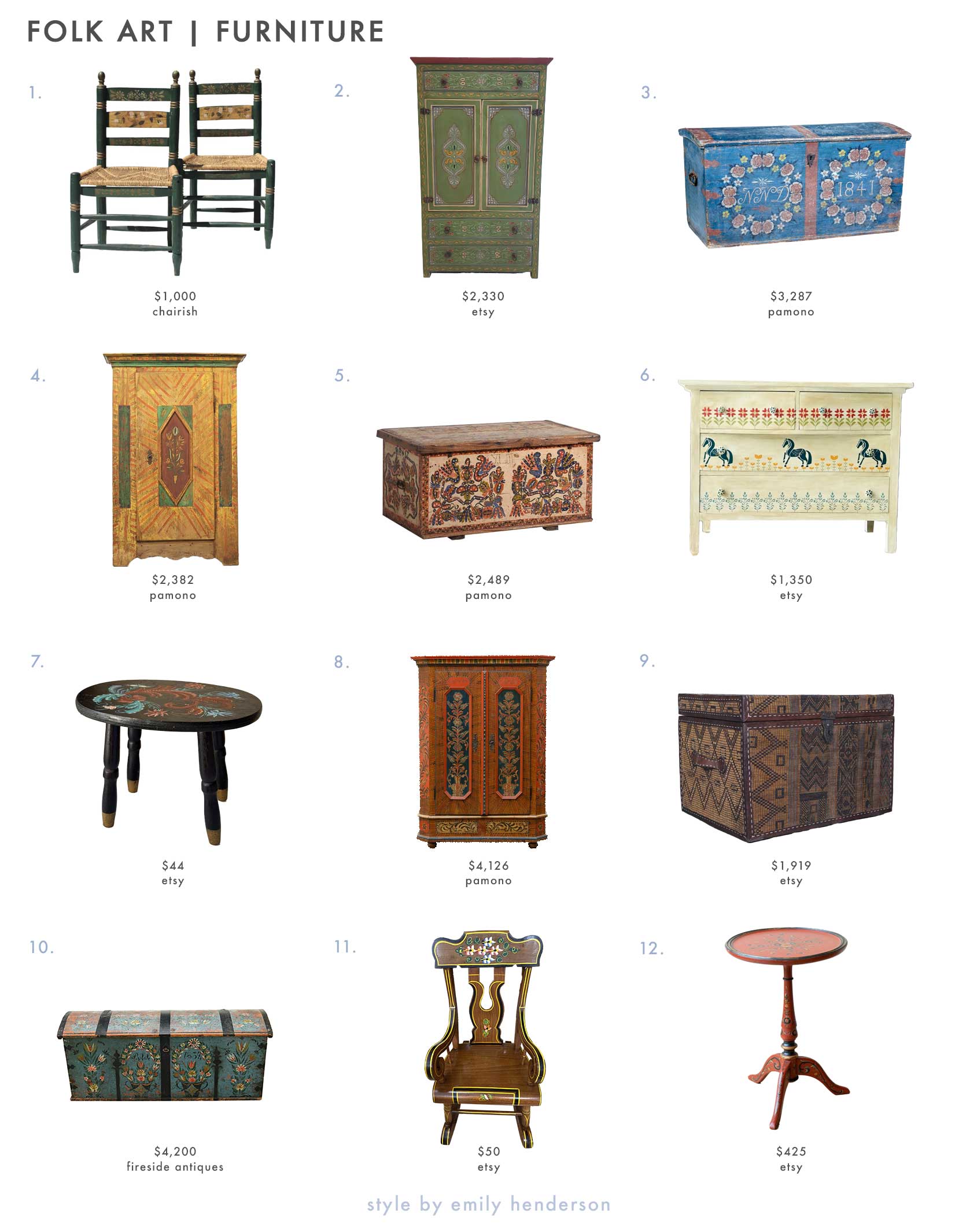
1. Pair of Mexican Folk Art Chairs in Green From the 1930s | 2. Hand Painted Green Moorish Armoire – 1990s | 3. Mid 19th Century Swedish Folk Art Hand Painted Pine Coffer | 4. Painted Folk Art Bridal Cupboard 18th Century Germany | 5. Antique Hand Painted Folk Style Trunk, 1880s Transylvania | 6. Antique Painted Folk Art Dresser Chest | 7. Vintage Hand Painted Norwegian Rosemaling Black Decorative Stool | 8. Hand-Painted Folk Wardrobe with Monogrammed AMW, Southern Germany, 1824 | 9. Vintage Handmade African Tuareg Chest | 10. Swedish 19th Century Painted Pine Marriage Trunk | 11. Vintage 1965 Ebersol Childs Size Wooden Folk Art Handpainted Flowers Rocking Chair | 12. Antique Folk Art Dutch Pedestal Table
As you can see from the prices above, antique folk art furniture is, uh, expensive (much like all other antiques in general). But I wanted to include all of these, even if not a single reader is in the market for a $4,200 Swedish 19th-century painted pine marriage trunk, to train your eye a bit in what these things look like and what sorts of pieces exist. You never know what you might stumble upon on Craigslist, flea markets, garage sales and the like, and knowing what to look for is half the battle.
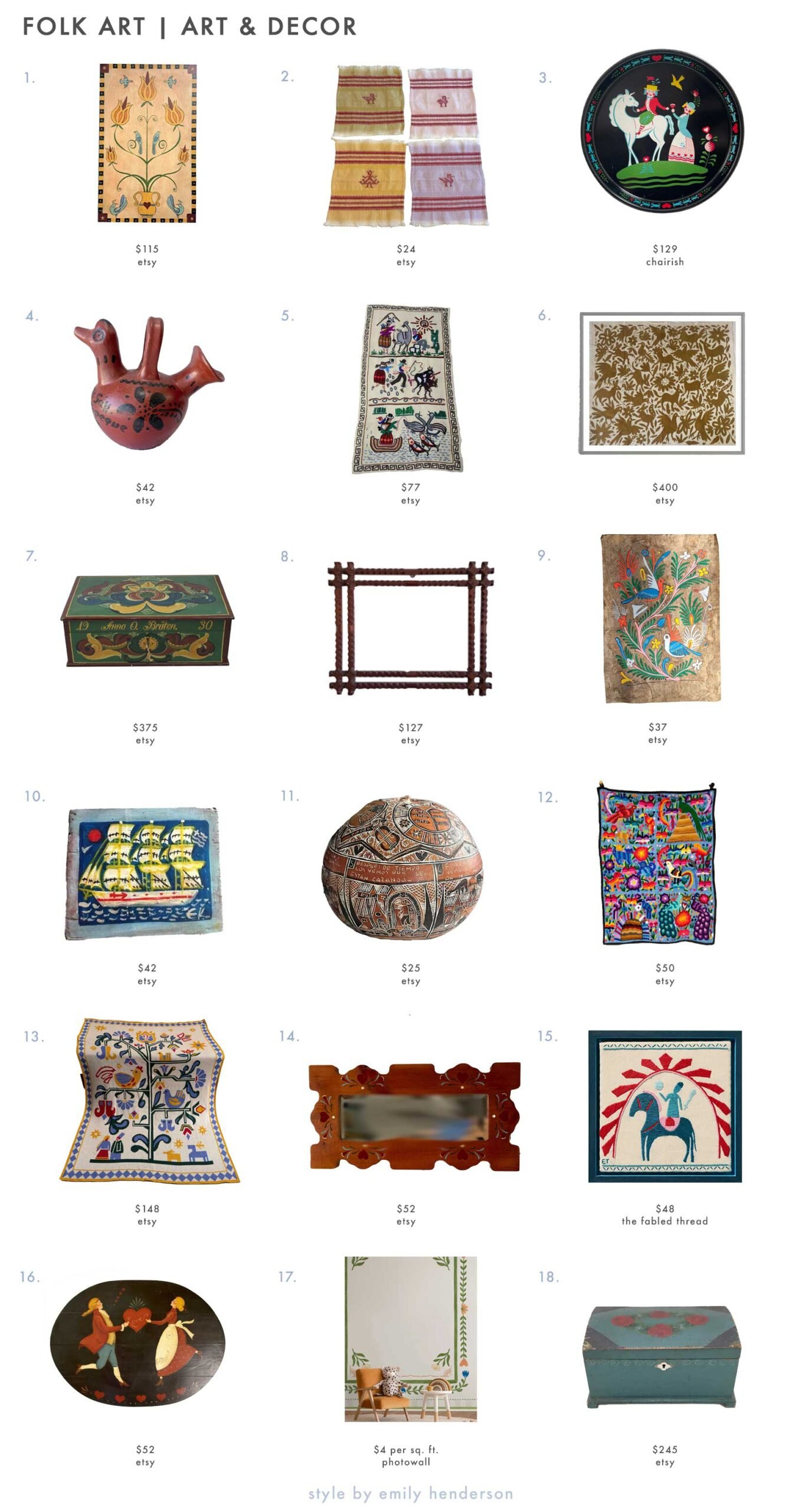
1. Pa Dutch Painting | 2. Set of 4 Vintage Guatemalan Handwoven Textiles Coasters | 3. Vintage Scandinavian Folk Art Metal Tray w/ Horse | 4. Vintage Guatemalan Folk Art Clay Bird | 5. Vintage Peruvian Wall Hanging | 6. Mexican Otomi Gold Hand Embroidered Wall Art | 7. Vintage Norwegian 1930 Rose Painted Trinket Chest | 8. Larger Simple Tramp Art Antique Carved wooden Picture Frame | 9. Vintage Amate Bark Painting 1970s Mexican Folk Art | 10. Vintage Greek Sailboat Painting on Salvaged Wood | 11. Mate Burilado Peruvian Hand Carved Gourd | 12. Vintage Hand Stitched Peruvian Style Embroidered Wool Wall Hanging | 13. Ukrainian Throw Hutsul Blanket | 14. Folk Art Beveled Mirror | 15. The Jabberwocky Act III Embroidery Kit | 16. Pennsylvania Dutch Tole Painted Wall Hanging | 17. Flower Foliage Frame – White II | 18. Antique Norwegian Painted Jewelry Box 1920s
Smaller pieces are, no surprise, far more affordable, and may be just the right dose of folk if you’re just dipping your toe in this style (plus, I think a little goes a LONG way in most homes). While some art is vintage or antique, there are also some picks that are meant to do yourself. For example, the embroidery kit (#15) from The Fabled Thread, or the wall appliqué from Photowall (#17).
—
I know that was a lot to take in, and honestly, I really only scratched the surface. It’s impossible to fully encompass the whole of folk art across the globe, but hopefully I gave you at least a taste of something that might strike your fancy. Enough to do your own deep dive or jump-start a hunt for a piece for your home.
Until next time, friends…
Opening Image Credits: Design by Emily Henderson | Photo by Kaitlin Green | From: The Full Reveal Of The Art Barn/Craft Shed Happens TODAY

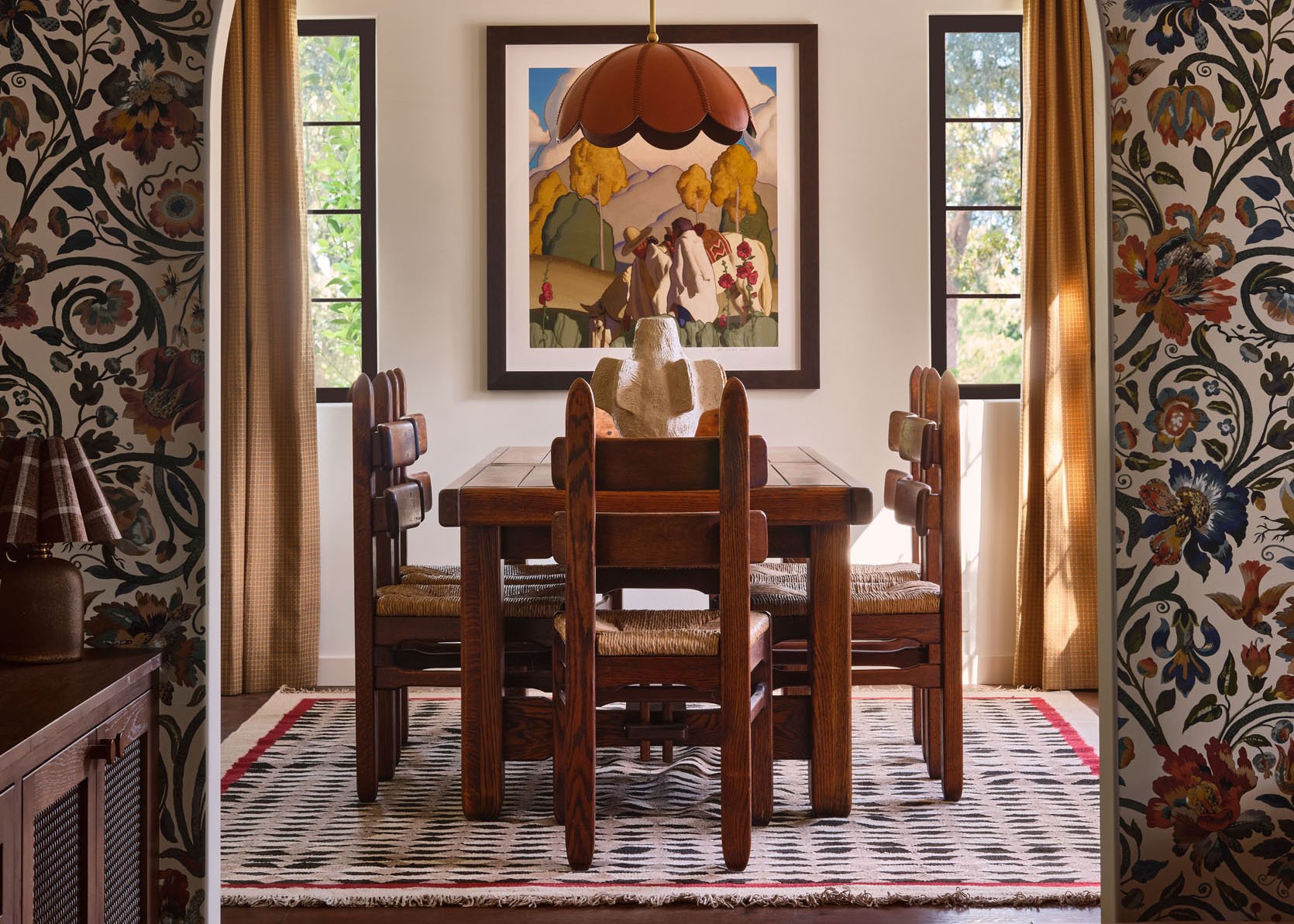
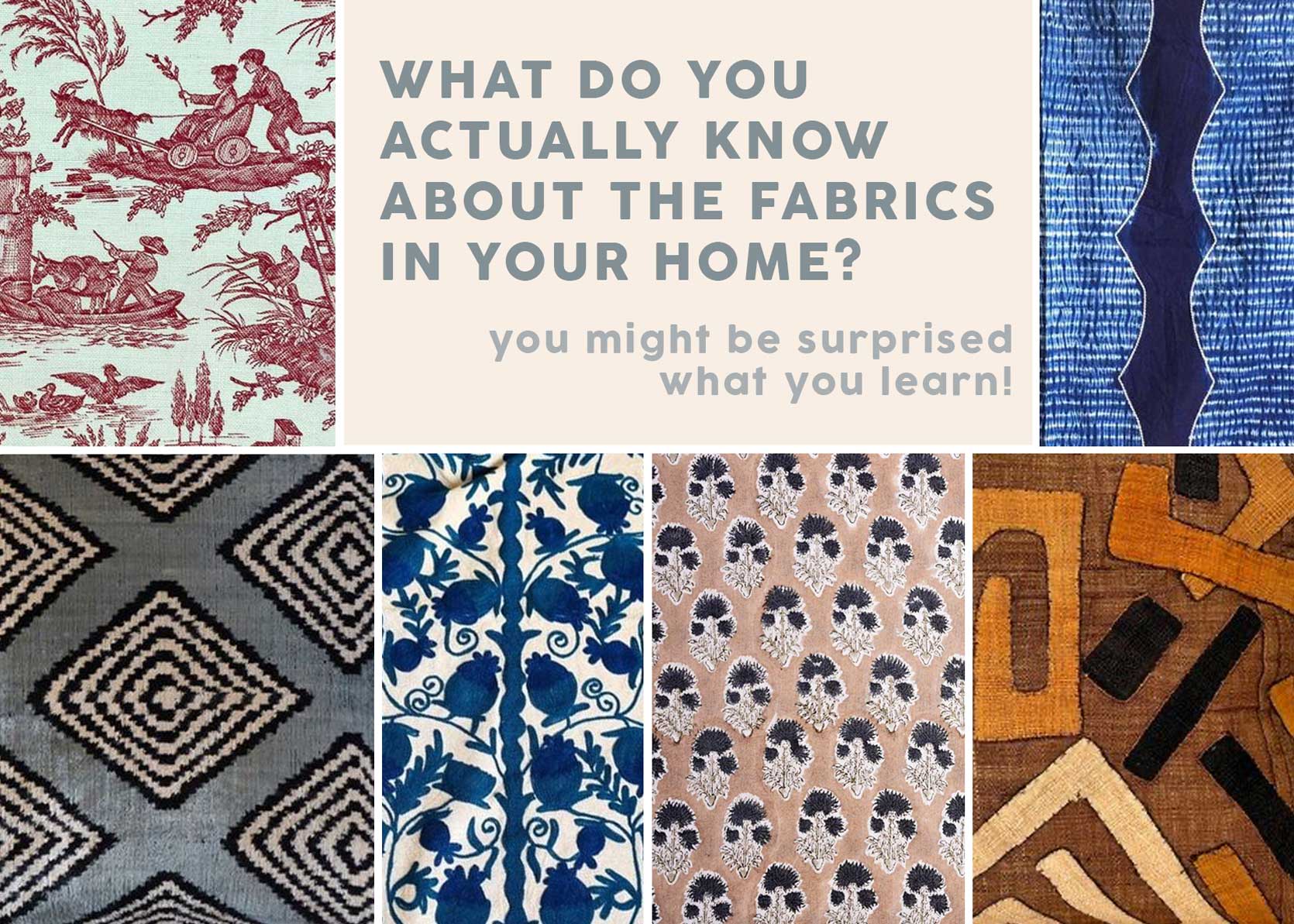

This is the sort of thing that makes my heart sing! Thanks a lot Arlyn, this was a lovely read. Could you please do a piece on folk art or vintage crockery from around the world? There is so much out there that I don’t know where to start and an Arlyn-guide is always a great starting point!
Awesome, awesome article. I adore folk art, especially while travelling but also via Etsy. We live in such a global age – that gives us access to a huge richness and it’s inevitable that it influences the mass market, but nothing beats the authentic article. I can’t wait to explore each and every link over a cup of tea.
Enjoy!
Once again, I LOVED this post from you. I always learn so much ! Thank you!
Thank you, Susan. 🙂
Just wanted to share that the folk art museum in Santa Fe is one of the best museums I have ever been to. Highly recommend. I could live in the diorama exhibit.
Yes, I didn’t touch on Southwest American folk art but that’s a HUGE category, as is native folk art. That could probably be its own post.
I’m a fabric and color lover, so Indian, African and Mexican textiles are scattered around my home (both authentic and inspiration pieces).
Thank you so much for this informative post! The painted chest you posted looks so much like a mural we found behind a backsplash in our kitchen reno. Thanks to this post, I now know it is Pennsylvania Dutch style. The revival of this style in the 1960s is the time period of the kitchen. In my google searching I learned about the popularity of hex signs. Low and behold, I had found one of these hex signs buried in my garden bed. I think it fell off the exterior of the house at some point. I hope to re-create both pieces to honor the legacy of our house.
I’m so happy this helped you unearth something!
Earlier this year I took a big chance on bringing this cabinet door into my contemporary home. I was so drawn to it and really couldn’t explain why. Honestly, it just does ‘something ‘ and gives a more soulful feel to the room. So happy I went with my gut!
Always go with your gut!
I love to see all of the genuine folk art, and antiques! How great that there are one of a kind pieces, in this mass production world.
As young Mom, in the late 80’s and 90’s, I was sure a bargain hunter! Those were the days of garage sales. I bought my share of wooden pieces, and painted, stenciled, and free handed designs on all kinds of pieces. I still have some of them, and have handed some down to my kids.
A book that is very well done in “Scandinavian painted furniture: a step-by-step workbook” by Jocasta Innnes. It was published in 1994. It may be findable in your local Library.
ooohhhh, thank you for this! Just put a hold on it at our library!
Thank you for that resource!
Jocasta Innes was/is the queen of painted finishes for us older Gen Xers. Love that she may be rediscovered by a new generation. All her books are treasures.
This is great! I’m actually in the process of developing a line of stencils to get this look. I’m crafty…but not an artist. I need a template to get things balanced and consistent. After tons of hunting around online for the right stencils, I came up empty…so looked into making my own and realized it’s not too hard! But, if anyone has any sources for good stencils, LMK! Still hunting for ideas 🙂
Making your own stencils! Interesting. Is that something you do digitally and then have someone/a company create for you?
Yes! We are sketching them by hand, scanning and refining digitally, and then we have a plastic guy who can fabricate them! Although, it hasn’t stopped us from at least browsing laser cutters so we could fully DIY it…maybe someday. 😉
Although it’s adjacent, I was hoping for maybe some decor from indigenous people for Indigenous Peoples Day. Maybe you’ll have a round up or guest contributor around National Day of Mourning
If you’re interested in trying to DIY a folk art look, I’ve seen stencil packs available for both Scandinavian and Mexican folk art motifs, although I’m sure there are more out there. If you are looking to bring in more of your own heritage, I would think doing it yourself would feel really meaningful.
This is such a fascinating topic! Folk art beautifully reflects the culture, history, and daily life of different regions. It’s amazing how each style carries unique stories and traditions through colors, patterns, and techniques. Ready to grow? Our website futuregrowacademy.com offers motivation and personal development guidance.
This post reminded me of how much I love Emily’s mural painted outside of the craft shed and the amazing furniture she covered in quilts. I love Norwegian folk art and haven’t really incorporated any into my house yet but now I am super inspired! I might even attempt to paint some old furniture I have kicking around here.
You’ve been on a roll with these interesting and fun posts. The folk art is so interesting and beautiful. I’m trying more and more to make my home less cookie cutter (hello whimsy!), and your recent posts have all be so great to read!
Thank you for including my Mexican chairs on Chairish from the turtle road shop! I love this series and am thrilled to be included! I cannot wait to read more.
Also I wanted to add that the book mentioned above is EXCELLENT. And I would love to see something on CastleCore!
I love this post! Thank you! In my travels I often bring home a piece of local folk art. My most recent trip took me to the San Blas Islands of Panama to learn about molas – and acquire a few. As a fabric lover and quilter, I’m mostly drawn to textiles. Every region of the world does amazing and unique things with textiles!
Beautifully explained! I love how you’ve combined functionality with aesthetics in your design approach
I’ve been saving this column til I had time to sit and digest- so so so good! Thank you for educating me (us) on these traditions!